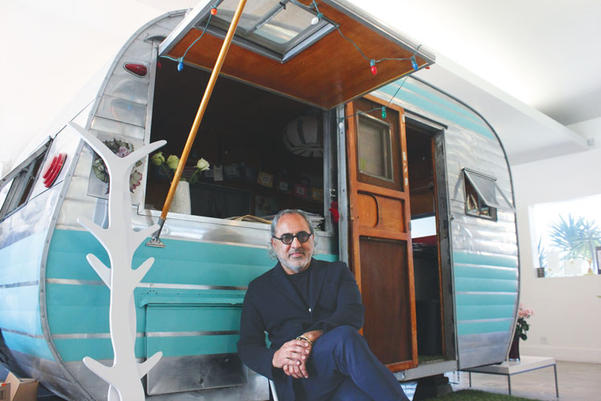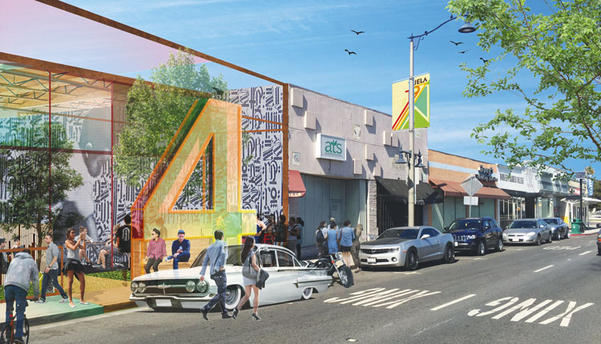For the last 25 years, LAB Holding LLC has been creating cultural retail and dining hubs in Southern California, including The LAB Anti-Mall, Anaheim Packing District and The CAMP, an eco-retail campus. In all, the organization has developed and continues to manage 42 unique projects. The LAB is preparing for its first foray into Long Beach with its development of 59 parcels spread out along the Atlantic Avenue corridor, collectively and tentatively named Canvas.

Shaheen Sadeghi, founder of LAB Holding, said the company’s North Long Beach development, tentatively named Canvas, will bring maker culture and artisans to the area. (Photograph by the Business Journal’s Brandon Richardson)
“I think any area that is attracting the creative culture and people who are free enough to get creative and experiment is for us,” LAB Holding Founder Shaheen Sadeghi said. “I think areas that haven’t disregarded their youth and creative cultures are very exciting. We like Long Beach because there is that culture there and it seems to be getting stronger.”
An economic divide has cut off certain communities from amenities such as a variety of dining options, local coffee shops and breweries, and other artisans, Sadeghi explained. The LAB’s philosophy is that everyone is “cool” and that economic status and the neighborhoods they live in should not limit them from enjoying these types of amenities. Overlooked and neglected areas have a richness that can be brought out through the right investments to bring a cool project to cool people, he added.
LAB is an acronym for “Little American Business.” It was founded to promote localization, personalization and customization in its projects, as opposed to what Sadeghi described as the typical homogenized developments that usually have the same national tenants.
“The products that these neglected neighborhoods want are the same products that everyone else wants. They don’t want another national chain like Subway. It’s not that Subway is bad, but [residents] are looking for localization,” Sadeghi said. “What that says is that all of these neighborhoods are looking to develop and promote their own community, their own commune.”
Aside from introducing more localized dining concepts, Sadeghi said he hopes to fill space at Canvas with an independent coffee shop, a pub or brewery, and goods makers. The creative maker culture – furniture craftsmen, apparel makers, leather workers and artists, for example – is a primary target for Canvas, Sadeghi explained. These maker businesses could use their space to create their goods and then sell them right out of their workspaces.
The current topography of Atlantic Avenue is not an environment that encourages socializing and coming together as a community, Sadeghi said, noting the area’s narrow sidewalks. To create a more connected community, many buildings in the upcoming development will have recessed storefronts for people to hang out, bump into friends and have conversations while enjoying food and drinks or perusing goods.

One of the main focuses of LAB Holding’s development plan for 59 parcels in North Long Beach is to create community spaces by recessing existing storefronts along the Atlantic Avenue corridor and incorporating seating and landscaping. (Rendering courtesy of LAB Holding)
The LAB is known for preserving buildings at its development sites because old structures represent an area’s history and tell a story, Sadeghi explained. In the case of North Long Beach, he said that some of the nine existing structures the company purchased have interesting architectural elements that the firm will work to preserve. However, he described the remaining buildings as flat and having little detail. He said these buildings and the vacant lots are where “front yard” type areas will be developed.
“My hope is that surrounding property owners and the neighborhood will invest in the area once they see the potential of this next generation of what the community can look like,” Sadeghi said. “I’m hoping they feel pride in the community and they do some cool things.”
While Sadeghi described the architecture and design of the project as the hardware, he said the software is the various programming that will be introduced over time. He explained that the LAB has a community development team for each of its projects that puts together art and music shows, develops vegetable gardens, offers free workshops and yoga classes, and a number of other activities to engage residents.
The LAB is currently in the middle of the permitting process with the city for Canvas, which will open in phases over the next three years. The adaptive reuse properties could begin opening as soon as summer of next year, Sadeghi explained, while new construction sites could take anywhere between two and three years. One factor that could impact the project timeline is if the city requires additional work from the LAB such as traffic and parking studies. Whatever the timeline, Sadeghi said, the organization is here for the long haul.
“We are prepared to pick up other pieces and continue to invest in North Long Beach. We have never sold anything in our 25 years. We continue to operate our own products,” Sadeghi said. “These are long-term projects for us and they continue to evolve. The whole thing comes along organically, it’s not just some instant neighborhood. Those instant neighborhoods look fake, they lose authenticity. I like this slow process of having the neighborhood come up.”
